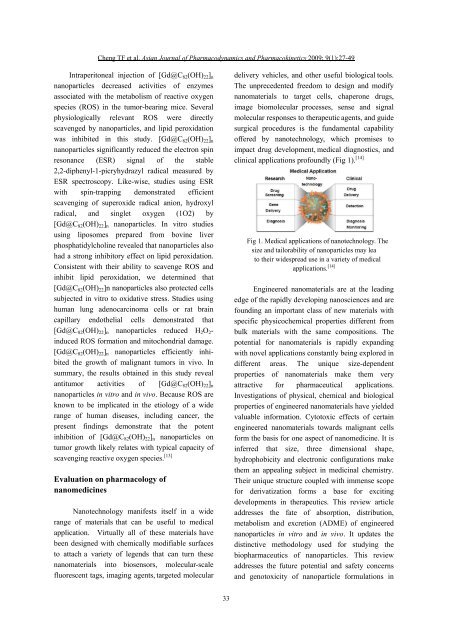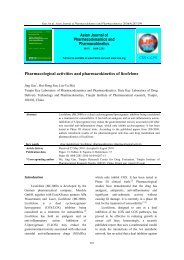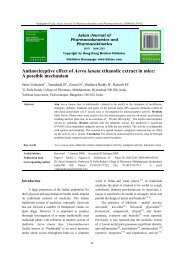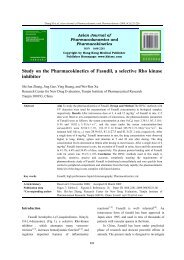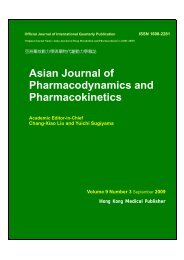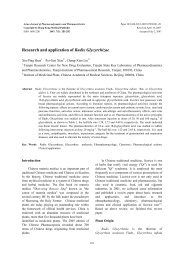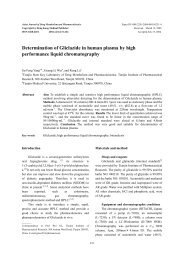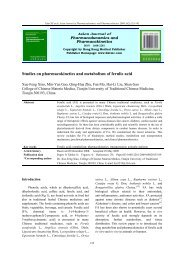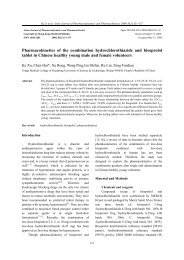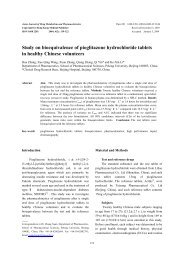Asian Journal of Pharmacodynamics and Pharmacokinetics
Asian Journal of Pharmacodynamics and Pharmacokinetics
Asian Journal of Pharmacodynamics and Pharmacokinetics
Create successful ePaper yourself
Turn your PDF publications into a flip-book with our unique Google optimized e-Paper software.
Cheng TF et al. <strong>Asian</strong> <strong>Journal</strong> <strong>of</strong> <strong>Pharmacodynamics</strong> <strong>and</strong> <strong>Pharmacokinetics</strong> 2009; 9(1):27-49<br />
Intraperitoneal injection <strong>of</strong> [Gd@C 82 (OH) 22 ] n<br />
nanoparticles decreased activities <strong>of</strong> enzymes<br />
associated with the metabolism <strong>of</strong> reactive oxygen<br />
species (ROS) in the tumor-bearing mice. Several<br />
physiologically relevant ROS were directly<br />
scavenged by nanoparticles, <strong>and</strong> lipid peroxidation<br />
was inhibited in this study. [Gd@C 82 (OH) 22 ] n<br />
nanoparticles significantly reduced the electron spin<br />
resonance (ESR) signal <strong>of</strong> the stable<br />
2,2-diphenyl-1-picryhydrazyl radical measured by<br />
ESR spectroscopy. Like-wise, studies using ESR<br />
with spin-trapping demonstrated efficient<br />
scavenging <strong>of</strong> superoxide radical anion, hydroxyl<br />
radical, <strong>and</strong> singlet oxygen (1O2) by<br />
[Gd@C 82 (OH) 22 ] n nanoparticles. In vitro studies<br />
using liposomes prepared from bovine liver<br />
phosphatidylcholine revealed that nanoparticles also<br />
had a strong inhibitory effect on lipid peroxidation.<br />
Consistent with their ability to scavenge ROS <strong>and</strong><br />
inhibit lipid peroxidation, we determined that<br />
[Gd@C 82 (OH) 22 ]n nanoparticles also protected cells<br />
subjected in vitro to oxidative stress. Studies using<br />
human lung adenocarcinoma cells or rat brain<br />
capillary endothelial cells demonstrated that<br />
[Gd@C 82 (OH) 22 ] n nanoparticles reduced H 2 O 2 -<br />
induced ROS formation <strong>and</strong> mitochondrial damage.<br />
[Gd@C 82 (OH) 22 ] n nanoparticles efficiently inhibited<br />
the growth <strong>of</strong> malignant tumors in vivo. In<br />
summary, the results obtained in this study reveal<br />
antitumor activities <strong>of</strong> [Gd@C 82 (OH) 22 ] n<br />
nanoparticles in vitro <strong>and</strong> in vivo. Because ROS are<br />
known to be implicated in the etiology <strong>of</strong> a wide<br />
range <strong>of</strong> human diseases, including cancer, the<br />
present findings demonstrate that the potent<br />
inhibition <strong>of</strong> [Gd@C 82 (OH) 22 ] n nanoparticles on<br />
tumor growth likely relates with typical capacity <strong>of</strong><br />
scavenging reactive oxygen species. [13]<br />
Evaluation on pharmacology <strong>of</strong><br />
nanomedicines<br />
Nanotechnology manifests itself in a wide<br />
range <strong>of</strong> materials that can be useful to medical<br />
application. Virtually all <strong>of</strong> these materials have<br />
been designed with chemically modifiable surfaces<br />
to attach a variety <strong>of</strong> legends that can turn these<br />
nanomaterials into biosensors, molecular-scale<br />
fluorescent tags, imaging agents, targeted molecular<br />
delivery vehicles, <strong>and</strong> other useful biological tools.<br />
The unprecedented freedom to design <strong>and</strong> modify<br />
nanomaterials to target cells, chaperone drugs,<br />
image biomolecular processes, sense <strong>and</strong> signal<br />
molecular responses to therapeutic agents, <strong>and</strong> guide<br />
surgical procedures is the fundamental capability<br />
<strong>of</strong>fered by nanotechnology, which promises to<br />
impact drug development, medical diagnostics, <strong>and</strong><br />
clinical applications pr<strong>of</strong>oundly (Fig 1). [14]<br />
Fig 1. Medical applications <strong>of</strong> nanotechnology. The<br />
size <strong>and</strong> tailorability <strong>of</strong> nanoparticles may lea<br />
to their widespread use in a variety <strong>of</strong> medical<br />
applications. [14]<br />
Engineered nanomaterials are at the leading<br />
edge <strong>of</strong> the rapidly developing nanosciences <strong>and</strong> are<br />
founding an important class <strong>of</strong> new materials with<br />
specific physicochemical properties different from<br />
bulk materials with the same compositions. The<br />
potential for nanomaterials is rapidly exp<strong>and</strong>ing<br />
with novel applications constantly being explored in<br />
different areas. The unique size-dependent<br />
properties <strong>of</strong> nanomaterials make them very<br />
attractive for pharmaceutical applications.<br />
Investigations <strong>of</strong> physical, chemical <strong>and</strong> biological<br />
properties <strong>of</strong> engineered nanomaterials have yielded<br />
valuable information. Cytotoxic effects <strong>of</strong> certain<br />
engineered nanomaterials towards malignant cells<br />
form the basis for one aspect <strong>of</strong> nanomedicine. It is<br />
inferred that size, three dimensional shape,<br />
hydrophobicity <strong>and</strong> electronic configurations make<br />
them an appealing subject in medicinal chemistry.<br />
Their unique structure coupled with immense scope<br />
for derivatization forms a base for exciting<br />
developments in therapeutics. This review article<br />
addresses the fate <strong>of</strong> absorption, distribution,<br />
metabolism <strong>and</strong> excretion (ADME) <strong>of</strong> engineered<br />
nanoparticles in vitro <strong>and</strong> in vivo. It updates the<br />
distinctive methodology used for studying the<br />
biopharmaceutics <strong>of</strong> nanoparticles. This review<br />
addresses the future potential <strong>and</strong> safety concerns<br />
<strong>and</strong> genotoxicity <strong>of</strong> nanoparticle formulations in<br />
33


